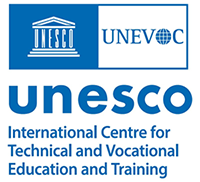
The UNESCO-UNEVOC International Centre: Who We Are | What We Do | Working With Us | Get in Touch
The UNEVOC Network: Learn About the Network | UNEVOC Network Directory
For Members: UNEVOC Centre Dashboard
Thematic Areas: Inclusion and Youth | Digital Transformation | Private Sector Engagement | SDGs and Greening TVET
Our Key Programmes & Projects: BILT: Bridging Innovation and Learning in TVET | Building TVET resilience | TVET Leadership Programme | WYSD: World Youth Skills Day
Past Activities: COVID-19 response | i-hubs project | TVET Global Forums | Virtual Conferences | YEM Knowledge Portal
Our Services & Resources: Publications | TVET Forum | TVET Country Profiles | TVETipedia Glossary | Innovative and Promising Practices | Toolkits for TVET Providers | Entrepreneurial Learning Guide
Events: Major TVET Events | UNEVOC Network News
UNEVOC U.S. Centre on Education and Training for Employment
 The Center on Education and Training for Employment (CETE) is the first UNEVOC Network member in the USA. CETE engages with state, national, and international clients from education, governmental agencies, organized labor, and public and private entities to:
The Center on Education and Training for Employment (CETE) is the first UNEVOC Network member in the USA. CETE engages with state, national, and international clients from education, governmental agencies, organized labor, and public and private entities to:
The Centre conducts seminars institutes to train persons to be facilitators of the DACUM process. DACUM job/occupational analysis process (DACUM stands for “Developing a Curriculum”) has proven to be a best practice example for many reasons. It has been demonstrated as being a very effective, quick, and low-cost process for use at the secondary and especially at the postsecondary levels. It is a way of involving business and industry in a substantive way to answer the question of “What should be taught in TVET programmes?”
DACUM meets the needs of industry by directly involving expert workers from any job or occupational area to accurately specify the tasks (competencies) needed by employers, and it can be used with skilled, technical, supervisory, and management positions, usually eliciting strong support from the employers for the training programme.
The DACUM process has been used by educators in over 40 countries. It is a very effective way of involving practitioners who are expert at what they do to identify the knowledge, skills and behaviours that should be taught to TVET students. Due to the involvement of local employees, it customizes the curriculum to their needs.
Teaching what really should be taught has a very positive influence on providing demand-driven knowledge, skills, and behaviours, hence increasing the student’s chance of employment and success in the workplace.
A second process that the CETE has used with much success is the SCID (Systematic Curriculum and Instructional Development) process. This week-long workshop process takes trainees through conducting training needs analysis, task verification, task selection, task analysis, clustering tasks into competencies, and the development of learner-centred, competency-based instructional materials. The materials developed usually include learning guides (modules) and job aids. Each participant is individually mentored to develop an instructional package on a task or competency of his/her choosing. The last day of the workshop is devoted to a discussion of program implementation and evaluation procedures.
A third process that has worked well and has been used extensively is competency assessment development and a Webxam online delivery system. Using blueprints from a job/occupational and task analysis, assessment tests are developed for measuring student competency attainment and certification. The assessments developed are written, reviewed, and validated by subject-matter experts who are highly regarded in their fields under the guidance of trained staff members.
Our experience includes the development of objective and performance-based assessments for programmes related to a wide array of careers. An online assessment delivery system is used because of its numerous advantages over paper-pencil systems such as: security, immediate feedback, and various reporting options.
The Webxam system is being used to administer state-wide exams that assess student knowledge in Ohio’s TVET programmes and also hosts exams for certification programs nationwide.
A common examination is a 100-item multiple-choice end-of-program exam, but a series of shorter modular exams (20 to 30 items) can be designed to use as material and is covered throughout a two-year occupational programme.
The Centre conducts Test Development Workshops to train TVET educators to use job analysis information to create assessments.
Links
UNESCO-UNEVOC U.S. Centre on Education and Training for Employment (UNEVOC Network Online Directory)
Contact
Robert E. Norton, DACUM/SCID/PBTT Program Director, Center on Education and Training for Employment, The Ohio State University, norton.1(at)osu.edu